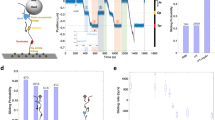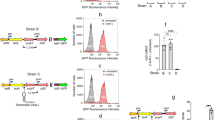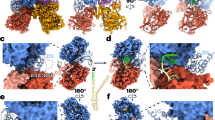Abstract
Supercoiled DNAs are required or preferred in a number of biological processes such as repair and transcription. This requirement may be due to special properties which are present in supercoiled (FI) DNAs but not in the corresponding allomorphic forms. If sufficiently supercoiled, FI DNAs seem to contain single-stranded regions that are accessible to single-strand specific reagents and endonuclease1–3. The free energy associated with super helix formation may also be used to drive ligand–DNA or protein–DNA interactions3–7. In vitro studies have shown that superhelical DNA is a better template for transcription than its corresponding allomorphic forms8–15, and this is due probably to a change in the initial binding affinity of the RNA polymerase at promoter sites15–18. Previous work in our laboratory has suggested that the single-strand specific probe N-cyclohexyl-N′-β-(4-methylmorpholinium) ethyl carbodiimide (CMC), which almost totally inhibits transcription of SV40 and PM2 DNA14,18, is acting preferentially at promotor sites18–20. We report here experiments to determine the selectivity of CMC for promoters on superhelical SV40 DNA. After limited reaction with CMC there was substantially less Escherichia coli RNA polymerase bound to reacted SV40 DNA than to the unmodified DNA. Marked inhibition of transcription from the modified DNA demonstrated that CMC is highly selective for E. coli RNA polymerase promotors in superhelical DNA, suggesting that the introduction of superhelical turns may alter the parameters by which the enzyme interacts with DNA through promotor recognition and opening of the DNA.
This is a preview of subscription content, access via your institution
Access options
Subscribe to this journal
Receive 51 print issues and online access
$199.00 per year
only $3.90 per issue
Buy this article
- Purchase on SpringerLink
- Instant access to full article PDF
Prices may be subject to local taxes which are calculated during checkout
Similar content being viewed by others
References
Lebowitz, J., Chaudhuri, A. K., Gonenne, A. & Kitos, G. Nucleic. Acids Res. 4, 1695–1712 (1977).
Pritchard, A. E., Kowalski, D. & Laskowski, M. J. biol. chem. 252, 8652–8659 (1977).
Bauer, W. R. A. Rev Biophys. Bioengng. 7, 287–331 (1978).
Bauer, W. R. & Vinograd, J. J. molec. Biol. 47, 419–435 (1970).
Davidson, J. J. molec. Biol. 66, 307–309 (1972).
Hsieh, T.-S. & Wang, J. C. Biochemistry 14, 527–535 (1975).
Bauer, W. R. & Vinograd, J. in Basic Principles of Nucleic Acid Chemistry Vol. 2 (eds Cantoni, G. L. & Davies D. R.) 265–303 (Academic, New York, 1974).
Hayashi, Y. & Hayashi, M. Biochemistry 10, 4212–4218 (1971).
Botchan, P., Wang, J. C. & Echols, H. Proc. natn. Acad. Sci. U.S.A. 70, 3077–3081 (1973).
Wang, J. C. J. molec. Biol. 89, 783–801 (1974).
Richardson, J. P. Biochemistry 13, 3164–3169 (1974).
Zimmer, S. G. & Millett, R. L. Biochemistry 14, 300–306 (1975).
Mandel, J. L. & Chambon, P. Eur. J. Biochem. 42, 367–378 (1974).
Flashner, M. S., Katopes, M. A. & Lebowitz, J. Nucleic. Acids Res. 4, 1713–1726 (1977).
Hale, P. & Lebowitz, J. J. Virol. 25, 298–304 (1978).
Richardson, J. P. J. molec. Biol. 91, 477–487 (1975).
Botchan, P. J. molec. Biol. 105, 161–176 (1976).
Hale, P. & Lebowitz, J. J. Virol. 25, 305–311 (1978).
Chen, M., Lebowitz, J. & Salzman, N. P. J. Virol. 18, 211–217 (1976).
Lebowitz, P., Stern, R., Ghosh, P. K. & Weissman, S. M. J. Virol. 22, 430–445 (1977).
Lebowitz, J., Garon, C. F., Chen, M. & Salzman, N. P. J. Virol. 18, 205–210 (1976).
Bauer, W. & Vinograd, J. Ann. N. Y. Acad. Sci. 164, 192–225 (1969).
Wells, R. D. et al. CRC Crit. Rev. Biochem. 4, 305–340 (1977).
Selsing, E., Wells, R. D., Alden, C. J. & Arnott, S. J. biol. Chem. 254, 5417–5422 (1979).
Shishido, K. Agric. biol. Chem. 43, 1093–1102 (1979).
Gilbert, W. in RNA Polymerase (eds Losick, R. & Chamberlin, M.) 193–205 (Cold Spring Harbor Lab. Mongr. Ser., 1976).
Mulder, C. & Delius, H. Proc. natn. Acad. Sci. U.S.A. 69, 3215–3219 (1970).
Yang, H.-L., Heller, K., Gelbert, M. & Zubay, G. Proc. natn. Acad. Sci. U.S.A. 76, 3304–3308 (1979).
Prives, C., Gilboa, E., Revel, M. & Winocour, E. Proc. natn. Acad. Sci. U.S.A. 74, 457–461 (1977).
Paucha, E., Harvey, R. & Smith, A. E. J. Virol. 28, 154–170 (1978).
Roberts, B. E. et al. Proc. natn. Acad. Sci. U.S.A. 72, 1922–1926 (1975).
Greenblatt, J. F., Allet, B., Weil, R. & Ahmed-Zadeh, C. J. molec. Biol. 108, 361–379 (1976).
Reddy, V. B. et al. Science 200, 494–502 (1978).
Reddy, V. B., Ghosh, P. K., Lebowitz, P. & Weissman, S. M. Nucleic Acids Res. 5, 4195–4213 (1978).
Dhar, R., Weissman, S. M., Zain, B. S., Pan, J. & Lewis, A. M., Nucleic Acids Res. 1, 595–614 (1974).
Scherer, G. E. F., Walkinshaw, M. D. & Arnott, S. Nucleic Acids Res. 5, 3759–3773 (1978).
Lescure, B., Chestier, A. & Yaniv, M. J. molec. Biol. 124, 73–85 (1978).
Lescure, B., Dauguet, C. & Yaniv, M. J. molec. Biol. 124, 87–95 (1978).
DeLorbe, W. J. thesis, Univ. Iowa (1978).
Gonzalez, N., Wigg, J. & Chamberlin, M. Arch. Biochem. Biophys. 182, 404–408 (1977).
Mangel, W. & Chamberlin, M. J. biol. Chem. 249, 2995–3001 (1974).
Kleinschmidt, A. K. in Methods in Enzymology Vol. XIIB (eds Colowick, S. P. & Kaplan, N. L.) 361–377 (Academic, New York, 1968).
Szybalski, W. & Szybalski, E. H. in Procedures in Nucleic Acid Research Vol. 2 (eds Cantoni, G. L. & Davies, D. R.) 311–354 (Harper and Row, New York, 1971).
Vinograd, J. & Hearst, J. Prog. Chem. Org. nat. Prod. Vol. 20 (ed. Zechmeister, J.) 373–422 (Springer, Vienna, 1962).
Crawford, L. V. et al. Proc. natn. Acad. Sci. U.S.A. 75, 117–121 (1978).
Berk, A. J. & Sharp, P. A. Proc. natn. Acad. Sci. U.S.A. 75, 1274–1278 (1978).
Author information
Authors and Affiliations
Rights and permissions
About this article
Cite this article
Hale, P., Woodward, R. & Lebowitz, J. E. coli RNA polymerase promoters on superhelical SV40 DNA are highly selective targets for chemical modification. Nature 284, 640–644 (1980). https://doi.org/10.1038/284640a0
Received:
Accepted:
Issue date:
DOI: https://doi.org/10.1038/284640a0
This article is cited by
-
DNA of the Streptomyces phage SH10: Binding sites for Escherichia coli RNA polymerase and denaturation map
Molecular and General Genetics MGG (1983)



